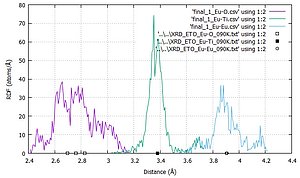Local structure of SrTiO3 and EuTiO3 studied by X-ray absorption spectroscopy
Dr.phys. Andris Anspoks (ISSP UL EXAFS laboratory)
Strontium titanate (SrTiO3, STO) is a well-known and thoroughly studied member of the familyof ABO3 oxides, which at room temperature has the cubic perovskite-type structure. Upon cooling,STO undergoes a second order Pm3m to I4/mcm antiferrodistorsive phase transition at ТС =105 K,with condensation of the R25 phonon mode at the Brillouin zone boundary [1]. The paraelectricphase of STO is retained down to the lowest temperatures (quantum paraelectricity [2]). At lowtemperatures, where quantum fluctuations dominate, the dielectric permittivity saturates and theferroelectric ordering is suppressed. Ferroelectricity in STO can be induced by suppression of thequantum fluctuations using isotope exchange (16O with 18O) [3].
Europium titanate (EuTiO3, ETO) has attracted tremendous interest recently caused by thediscovery of strong magneto-electric coupling at low temperature [4]. The correlation of a soft opticmode with antiferromagnetic order has subsequently been demonstrated [5] and raised the chance torealize true multiferroic coupling of electrical and magnetic properties. Recently a structuralinstability at TS=282K has been predicted in this material and has been confirmed experimentally[6]. This instability is driven by the condensation of a transverse acoustic zone boundary modestemming from the oxygen octahedral rotation, completely analogous to the one observed in STO.An essential property of ETO as compared to STO is the fact that this phase transition can beshifted to higher temperatures by a magnetic field [7], even though the system is far above the Néeltemperature and deep in the paramagnetic phase. This observation suggests that paramagnonphonon interactions are active at high temperatures yielding the presence of dynamically activemagnetic centers at the nanoscale. A confirmation of this assertion was achieved by novel muonspin rotation measurements under high magnetic fields [8], where a new critical temperature pointwas discovered, below which magnetic interactions become essential. However, also thistemperature is far above the Néel temperature TN=5.7K, namely at T*=200K. A similar conclusionwas obtained from recent resistivity data, where a strong enhancement of the resistance took placeunder a magnetic field around T*. By measuring the thermal expansion of ETO two strikingphenomena have been observed around TS and TN [9], where the former yields a cusp like anomalyin the thermal expansion, while the latter appears as a pronounced striction.
We will present our recent results about the local atomic structure extracted from X-rayabsorption spectroscopy data for ETO and STO at temperatures from 90 to 300 K. In our analysiswe use both x-ray absorption near edge structure (XANES) and extended x-ray absorption finestructure (EXAFS) data using our recently developed method combining reverse Monte-Carlo andevolutionary algorithms [10]. The obtained results show a clear difference of the instantaneousRDFs (example shown in Fig. 1) compared with average data obtained by XRD.Our focus will be on the similarities and differences between local structure of A and Bsublattice for STO [10] and ETO.
References
[1] G. Shirane, and Y. Yamada, Phys. Rev. 177, 858-863 (1969).
[2] Muller K A and Burkard H, Phys. Rev. B 19, 3593-3602 (1979).
[3] Taniguchi H, Itoh M, and Yagi T, Phys. Rev. Lett. 99: 017602 (2007).
[4] Katsufuji T., & Takagi H., Phys. Rev. B 64, 054415-054419 (2001).
[5] Goian, V., Kamba, S., Hlinka, J., Vaněk, P., Belik, A. A., Kolodiazhnyi, T., and Petzelt, J., J. Eur. Phys. J.B 71, 429-431 (2009).
[6] Bussmann-Holder A., Köhler J., Kremer R. K., and Law J. M., Phys. Rev. B 83, 212102 1-4 (2011).
[7] Guguchia, Z., Keller, H., Köhler, J., and Bussmann-Holder, A., J. Phys.: Condens. Matter 24, 492201(2012).
[8] Guguchia Z., Keller H., Kremer R.K., Köhler J., Luetkens H., Goko T., Amato A., and Bussmann-HolderA., Phys. Rev. B 90, 064413 1-6 (2014).
[9] P.G. Reuvekamp, R.K. Kremer, J. Köhler, and A. Bussmann-Holder, Phys. Rev. B 90, 094420 1-4(2014).
[10] A. Anspoks, J. Timoshenko, D. Bocharov, J. Purans, F. Rocca, A. Sarakovskis, V. Trepakov, A.Dejneka and M. Itoh, Ferroelectrics 482, 42-52 (2015).
